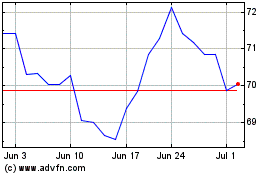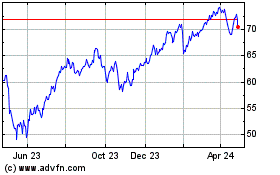MetLife Opts for Spinoff of Life Insurance Operations
October 05 2016 - 6:20PM
Dow Jones News
MetLife Inc. is opting for a spinoff to existing shareholders as
it divests a big chunk of its U.S. life-insurance business,
resolving one of the key questions about its plan to shrink for
regulatory and strategic reasons.
The plans, filed with the Securities and Exchange Commission,
put in motion the spinoff of operations representing about a fifth
of the company's most recent annual earnings. The company announced
this summer the new company will be known as Brighthouse
Financial.
MetLife said in a separate regulatory filing that the "ultimate
form and timing" of the divestiture would depend on factors
including regulatory considerations and economic conditions. The
company said it continues to evaluate possible other alternatives
for the separation, including an initial public offering or a
sale.
Wall Street analysts have largely discounted the chance of a
sale because of a paucity of buyers for a unit as large as the one
being divested. It will have about $240 billion in total assets,
and at that size, Brighthouse is expected to be one of the 15
largest life insurers in the U.S.
MetLife, with $942.6 billion in assets as of June 30, will slip
to second biggest after the split, behind Prudential Financial
Inc., at $796.5 billion in total assets.
Brighthouse will create life-insurance and retirement-income
products for sale in the U.S. to consumers through securities
brokerages, financial advisers and other outside sales forces. As
expected, the new chief executive will be Eric Steigerwalt, who is
currently a MetLife executive vice president in charge of the
business that is becoming Brighthouse.
In announcing the divestiture in January, MetLife said a goal
was easing some of the capital burden it was expected to face under
new federal regulations as a "systemically important financial
institution" regulated by the Federal Reserve.
A federal judge in March struck down the company's 2014
designation by a panel of federal regulators, but MetLife said it
intended to continue with the divestiture. That is partly because
the federal panel is appealing the ruling and MetLife could be
re-designated.
What's more, the divestiture is part of an effort by CEO Steven
Kandarian to separate the parts of the company with the best growth
prospects, such as overseas life-insurance operations, from parts
where growth is either slower or the products require especially
thick capital cushions. Regulators often require such cushions to
better ensure an insurer can fulfill promises to consumers.
Among other units MetLife is retaining its business as a leading
seller of life, dental and other insurance coverage to employers
for their benefit programs.
Write to Leslie Scism at leslie.scism@wsj.com
(END) Dow Jones Newswires
October 05, 2016 18:05 ET (22:05 GMT)
Copyright (c) 2016 Dow Jones & Company, Inc.
MetLife (NYSE:MET)
Historical Stock Chart
From Mar 2024 to Apr 2024

MetLife (NYSE:MET)
Historical Stock Chart
From Apr 2023 to Apr 2024
